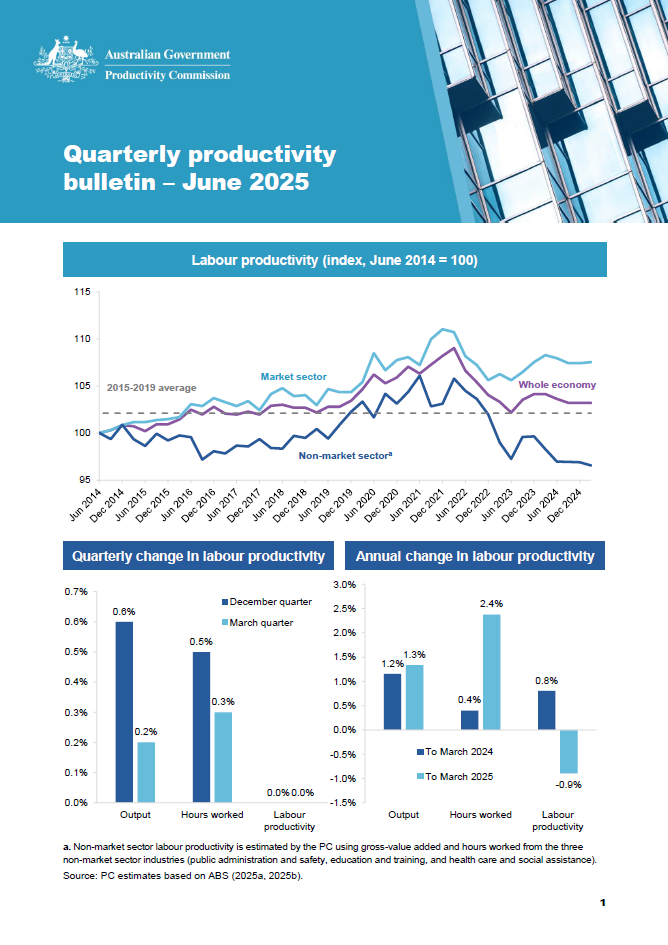Quarterly productivity bulletin - June 2025

PC productivity insights
Released 19 / 06 / 2025
The bulletin examines how Australians have responded to productivity growth since 1980. It finds that Australians have only modestly reduced their working hours, with the majority of the 'productivity dividend' allocated towards increased income.
It also unpacks the Australian Bureau of Statistics (ABS) June 2025 quarterly productivity statistics release. Labour productivity was stagnant in the March 2025 quarter and fell by 1% in the year to March.

Productivity bulletin: What Australians do with their productivity gains
The Productivity Commission’s June Quarterly Productivity Bulletin finds Australia's productivity woes continued in the March quarter.
Labour productivity was stagnant in the March quarter and declined by 1.0% over the year.
This bulletin highlights what we stand to gain by getting productivity moving again by looking at how Australians have benefited from productivity increases in recent decades.
Productivity improves when we can work the same number of hours but produce more, which ultimately means we receive more income for each hour of work. This gives us more choice about what we do with our time – we can work more hours to increase our incomes further, take more time off or a mix of both.
In her article, PC researcher Rusha Das looks at what Australians have done with this 'productivity dividend' over the past few decades.
“With the growth in labour productivity Australia has enjoyed since 1980, Australians could have reduced their average hours worked by 15 hours per week without lowering our consumption levels,” said Rusha.
“Instead, overall we used about 23% of the productivity dividend to work less, and we banked the other 77% as higher income.”
The article also looks at what other countries do with their productivity gains. For example, in France, people are strongly inclined towards preserving free time – their productivity dividend tends to go towards working less, rather than consuming more. By contrast, in the United States, the productivity dividend tends to go towards consuming more. Australia sits somewhere in between these two examples.
“Productivity growth gives us the freedom to choose between more income, more leisure, or a better mix of both. When productivity stalls, those choices remain unchanged. If productivity declines, the choices shrink," said Rusha.
“In our last bulletin, we found that our productivity problem is no flash in the pan. It is a long-term, structural challenge that requires dedicated attention from business and government,” said Deputy Chair Dr Alex Robson.
The PC will be helping to address Australia’s productivity challenge with recommendations in the interim reports of our five productivity inquiries in July and August.
Media requests
Media team – 02 6240 3330 / media@pc.gov.au
Quarterly productivity bulletin – June 2025
- Labour productivity update
- Update from Alex Robson
- All work and no play: Productivity and the choice between money and leisure
- References
- Copyright and publication detail
Appendix: Supporting evidence
- A primer on productivity
- Detailed productivity statistics
- Productivity data revisions
We value your comments about this publication and encourage you to provide feedback.

